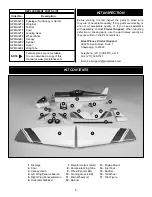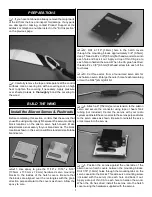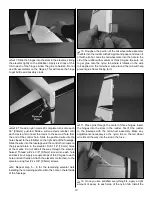
3
PROTECT YOUR MODEL, YOURSELF
& OTHERS… FOLLOW THESE
IMPORTANT SAFETY PRECAUTIONS
1. Your Revolver ARF should not be considered a toy, but
rather a sophisticated, working model that functions very
much like a full-size airplane. Because of its performance
capabilities, the Revolver, if not assembled and operated
correctly, could possibly cause injury to yourself or spectators
and damage to property.
2. You must assemble the model according to the
instructions. Do not alter or modify the model, as doing
so may result in an unsafe or unfl yable model. In a few
cases the instructions may differ slightly from the photos.
In those instances the written instructions should be
considered as correct.
3. You must take time to build straight, true and strong.
4. You must use an R/C radio system that is in fi rst-class
condition, and a correctly sized engine and components
(fuel tank, wheels, etc.) throughout the building process.
5. You must correctly install all R/C and other components
so that the model operates correctly on the ground and in
the air.
6. You must check the operation of the model before every
fl ight to insure that all equipment is operating and that the
model has remained structurally sound. Be sure to check
clevises or other connectors often and replace them if they
show any signs of wear or fatigue.
7. If you are not an experienced pilot or have not fl own
this type of model before, we recommend that you get the
assistance of an experienced pilot in your R/C club for
your fi rst fl ights. If you’re not a member of a club, your local
hobby shop has information about clubs in your area whose
membership includes experienced pilots.
8. While this kit has been fl ight tested to exceed normal use,
if the plane will be used for extremely high stress fl ying, such
as racing, or if an engine larger than one in the recommended
range is used, the modeler is responsible for taking steps to
reinforce the high stress points and/or substituting hardware
more suitable for the increased stress.
9. WARNING: The cowl and wheel pants included in this kit
are made of fi berglass, the fi bers of which may cause eye,
skin and respiratory tract irritation. Never blow into a part
to remove fi berglass dust, as the dust will blow back into
your eyes. Always wear safety goggles, a particle mask and
rubber gloves when grinding, drilling and sanding fi berglass
parts. Vacuum the parts and the work area thoroughly after
working with fi berglass parts.
We, as the kit manufacturer, provide you with a top quality,
thoroughly tested kit and instructions, but ultimately the
quality and fl yability of your fi nished model depends
on how you build it; therefore, we cannot in any way
guarantee the performance of your completed model,
and no representations are expressed or implied as to the
performance or safety of your completed model.
Remember: Take your time and follow the instructions to
end up with a well-built model that is straight and true.
DECISIONS YOU MUST MAKE
This is a partial list of items required to finish the
Revolver .61 ARF that may require planning or decision
making before starting to build. Order numbers are
provided in parentheses.
Radio Equipment
The Revolver .61 ARF requires a minimum 4-channel radio
system with fi ve 50 oz.-in. [3.6 kg-cm] minimum standard
servos. If you are installing a glow engine, an additional
standard servo is required for the throttle.
In addition, two 6" [152mm] servo extensions are required
for the aileron servos. If you are using a radio system that
does not support mixing functions, a Y-harness will also be
required to connect the aileron servos to the receiver.
If you plan to install a brushless motor, you will need a 6"
[152mm] servo extension for the ESC. If you plan to install a
glow engine, you will need a 12" [305mm] servo extension
for the receiver battery pack.
A charge jack receptacle is optional, but is useful for
recharging the receiver pack without removing the
canopy hatch and is shown in the assembly of the plane.
Recommended part numbers for the radio components are
provided below:
❏
Futaba
®
S9001 Servo Aircraft Coreless BB
(FUTM0075)
❏
Hobbico
®
Pro
™
HD Extension 6" [152mm] Futaba J
(HCAM2701)
❏
Hobbico Pro HD Y-Harness Futaba J (HCAM2751)
❏
Hobbico Pro HD Extension 12" [305mm] Futaba J
(HCAM2711)
❏
Ernst Charge Receptacle Futaba J FM (ERNM3001)


















